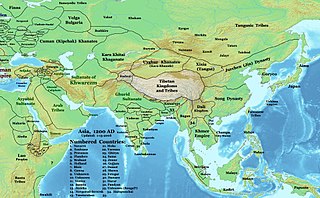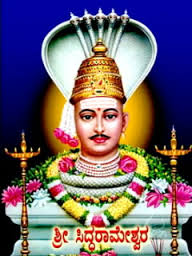Related Research Articles

Basaveshwara, colloquially known as Basavanna, was a 12th-century CE Indian statesman, philosopher, poet, Lingayat social reformer in the Shiva-focussed bhakti movement, and a Hindu Shaivite social reformer during the reign of the Kalyani Chalukya/Kalachuri dynasty. Basava was active during the rule of both dynasties but reached the peak of his influence during the rule of King Bijjala II in Karnataka, India.

Kannada literature is the corpus of written forms of the Kannada language, a member of the Dravidian family spoken mainly in the Indian state of Karnataka and written in the Kannada script.

Akka Mahadevi ಅಕ್ಕ ಮಹಾದೇವಿ (c.1130–1160) was one of the early female poets of the Kannada literature and a prominent person in the Lingayat Shaiva sect in the 12th century. Her 430 extant Vachana poems, and the two short writings called Mantrogopya and the Yogangatrividhi are considered her most notable contribution to Kannada literature. She composed fewer poems than other saints of the movement. The term Akka is an honorific given to her by great Lingayat saints such as Basavanna, Siddharama and Allamaprabhu and an indication of her high place in the spiritual discussions held at the "Anubhava Mantapa". She is seen as an inspirational woman in Kannada literature and in the history of Karnataka. She considered the god Shiva as her husband,.

Allamaprabhu was a 12th-century mystic-saint and Vachana poet of the Kannada language, propagating the unitary consciousness of Self and Shiva. Allamaprabhu is one of the celebrated poets and the patron saint of the Lingayata movement that reshaped medieval Karnataka society and popular Kannada literature. He is included among the "Trinity of Lingayathism", along with Basavanna, the founder of the movement, and Akka Mahadevi, the most prominent woman poet.

Hoysala literature is the large body of literature in the Kannada and Sanskrit languages produced by the Hoysala Empire (1025–1343) in what is now southern India. The empire was established by Nripa Kama II, came into political prominence during the rule of King Vishnuvardhana (1108–1152), and declined gradually after its defeat by the Khalji dynasty invaders in 1311.

A large body of Western Chalukya literature in the Kannada language was produced during the reign of the Western Chalukya Empire in what is now southern India. This dynasty, which ruled most of the western Deccan in South India, is sometimes called the Kalyani Chalukya Dynasty after its royal capital at Kalyani, and sometimes called the Later Chalukya Dynasty for its theoretical relationship to the 6th-century Chalukya dynasty of Badami. For a brief period (1162–1183), the Kalachuris of Kalyani, a dynasty of kings who had earlier migrated to the Karnataka region from central India and served as vassals for several generations, exploited the growing weakness of their overlords and annexed the Kalyani. Around 1183, the last Chalukya scion, Someshvara IV, overthrew the Kalachuris to regain control of the royal city. But his efforts were in vain, as other prominent Chalukya vassals in the Deccan, the Hoysalas, the Kakatiyas and the Seunas destroyed the remnants of the Chalukya power.
Chamarasa was a 15th century Virashaiva poet in the Kannada language, during the reign of Vijayanagar Empire, a powerful empire in Southern India during 14th - 16th centuries. A contemporary and competitor to a noted Brahmin Kannada poet Kumara Vyasa, Chamarasa was patronised by King Deva Raya II. The work is in 25 chapters (gatis) comprising 1111 six-line verses (shatpadi).
Rudrabhatta was an influential 12th-century Kannada poet in the court of the Hoysala Empire King Veera Ballala II(r.1173–1220 CE). According to Kannada language expert Narasimhacharya, the poet was also patronized by a minister of the King. The literary critic Mukherjee feels that after a century of literary revolution caused by the Veerashaiva poets, a benevolent atmosphere created by the king may have encouraged this Vaishnava writer and poet.

Vachana sahitya is a form of rhythmic writing in Kannada that evolved in the 11th century and flourished in the 12th century, as a part of the Sharana movement. Madara Chennaiah, an 11th-century cobbler-saint who lived during the reign of the Western Chalukyas is regarded by some scholars as the "father of Vachana poetry." The word "vachanas" literally means "(that which is) said". These are readily intelligible prose texts.
Kaivalya, is the ultimate goal of aṣṭāṅga yoga and means "solitude", "detachment" or "isolation", a vrddhi-derivation from kevala "alone, isolated". It is the isolation of purusha from prakṛti, and liberation from rebirth, i.e., Moksha. Kaivalya-Mukti is described in some Upanishads, such as Muktika and Kaivalya as the most superior form of Moksha which can grant liberation both within this life, as Jivanmukti, and after death, as Videhamukti.

Mysore literature in Kannada is a body of literature composed in the Kannada language in the historical Kingdom of Mysore in Southern India and written in the Kannada script. The writings date from the Kingdom of Mysore, which existed from around 1600 CE until the establishment of modern India in 1947. Many of the works of this literature written on religious themes are labeled Veerashaiva or Vaishnava in acknowledgment of the two faiths that gave form to the literature and fostered it until the advent of the modern era. Despite a gradual decline in the popularity of Jainism, authors devoted to the faith produced some works of merit. Secular themes dealing with a wide range of subjects were also written on. Kannada literature flourished for a short while in the court of the neighbouring kingdom of the Nayakas of Keladi whose territory was annexed by Mysore in 1763.

Gopala Dasa (1721–1769) was a prominent 18th-century Kannada language poet and saint belonging to the Haridasa tradition. With other contemporary Haridasas such as Vijaya Dasa and Jagannatha Dasa, Gopala Dasa propagated the Dvaita philosophy of Madhvacharya in South India through Kirtans known as Dasara Padagalu with the pen-name "Gopala Vittala".He is Ganesa Amsha.

Vijayanagara literature in Kannada is the body of literature composed in the Kannada language of South India during the ascendancy of the Vijayanagara Empire which lasted from the 14th through the 16th century. The Vijayanagara empire was established in 1336 by Harihara I and his brother Bukka Raya I. Although it lasted until 1664, its power declined after a major military defeat by the Shahi Sultanates in the battle of Talikota in 1565. The empire is named after its capital city Vijayanagara, whose ruins surround modern Hampi, now a World Heritage Site in Karnataka.
Ratnakaravarni was a 16th-century Kannada poet and writer. He is considered to be one of the trailblazers in the native shatpadi and sangatya metric tradition that was popularised in Kannada literature during the rule of the Vijayanagara empire in modern Karnataka. His most famous writing is the story of the Jain prince Bharata and is called the Bharatesha Vaibhava. Known to be a troubled and restless person, tradition has it that Ratnakaravarni converted from his religion Jainism to Veerashaivism when a less-meritorious poet superseded him. During this brief time, he wrote the Basavapurana, a biography of the 12th century social reformer Basavanna. Later, he returned to the Jain religion and penned classics in the shataka metre. His contributions to Kannada literature are considered trend setting.

Raghavanka was a noted Kannada writer and a poet in the Hoysala court who flourished in the late 12th to early 13th century. Raghavanka is credited for popularizing the use of the native shatpadi metre in Kannada literature. Harishchandra Kavya, in shatpadi metre, is known to have been written with an interpretation unlike any other on the life of King Harishchandra is well known and is considered one of the important classics of Kannada language. He was a nephew and protégé of the noted Early 12-century Kannada poet Harihara. Although the shatpadi metre tradition existed in Kannada literature prior to Raghavanka, Raghavanka inspired the usage of the flexible metre for generations of poets, both Shaiva and Vaishnava to come.
Harihara was a noted Kannada poet and writer in the 12th century. A native of Halebidu in modern Hassan district, he came from a family of accountants (Karnikas) and initially served in that capacity in the court of Hoysala King Narasimha I. Later, he moved to Hampi and authored many landmark classics. Among his important writings, the Girijakalyana written in champu metre is considered one of the enduring classics of Kannada language.

Lakshmisa was a noted Kannada language writer who lived during the mid-16th or late 17th century. His most important writing, Jaimini Bharata is a version of the Hindu epic Mahabharata. The writing focuses on the events following the battle of Indraprastha between the Pandavas and Kauravas, using the Ashvamedha conducted by Yudhishthira as the topic of the epic narrative. The writing is in the shatpadi metre and was inspired by the Sanskrit original written by sage Jaimini.

Jagannatha Dasa (1728–1809), a native of Manvi town in the Raichur district, Karnataka state, India,is a disciple of Madhvacharya and is considered one of the notable Haridasa of Dvaita Vedanta of Madhva saint-poets of the Kannada language. Apart from authoring numerous well-known devotional songs that propagate the Vaishnava bhakti ("faith") of Dvaita Vedanta of Madhvacharya, Jagannatha Dasa wrote the Harikathamritasara in the native shatpadi metre and Tattva suvali in the native tripadi metre. He was also an accomplished scholar in the Sanskrit language.
Palkuriki Somanatha was one of the most noted Telugu language writers of the 12th or 13th century. He was also an accomplished writer in the Kannada and Sanskrit languages and penned several classics in those languages. He was a Lingayat a follower of the 12th century social reformer Basava and his writings were primarily intended to propagate this faith. He was a well acclaimed Shaiva poet.

Siddheshwar also known as Siddharameshwar and Siddharama was one among the five acharya ("saint") of the Lingayat faith. Siddheshwar was a great contributor to Lingayat sampradaya of Hinduism. He was a great mystic and a Kannada poet who was a part of Basavanna's Lingayat revolution during the 12th century. His philosophy was one of service to mankind, the path of karmayoga. Siddarama was instrumental in saving the vachana literature from destruction. Shri Siddharameshwar was born in Solapur City of Maharashtra.
References
- Shiva Prakash, H.S. (1997). "Kannada". In Ayyappapanicker (ed.). Medieval Indian Literature:An Anthology. Sahitya Akademi. ISBN 81-260-0365-0.
- Various (1988) [1988]. Encyclopaedia of Indian literature – vol 2. Sahitya Akademi. ISBN 81-260-1194-7.
- Various (1987) [1987]. Encyclopaedia of Indian literature – vol 1. Sahitya Akademi. ISBN 81-260-1803-8.